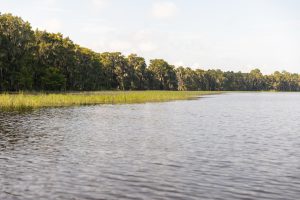Scientists come from all different backgrounds, often inspired by their personal interests or passions. I am fortunate to be one of those scientists. I research aquatic plant management, which is directly related to my favorite hobby, fishing.
I grew up in Citrus County, Florida, which is sprinkled with multiple freshwater systems and access to the gulf coast. In Citrus County, you are never far from water, which is why I naturally took to fishing from an early age. I frequented the Tsala Apopka chain, Lake Rouseau, Withlacoochee River, and Lake Panasoffkee; always searching for my next personal best largemouth bass or looking for a spot to fill a cooler with crappie.

Life on the Lake
After high school, I left Citrus County to attend the University of Florida for my bachelor’s and master’s degrees in general agronomy and weed science. During college, I rented a house on Orange Lake that allowed me to continue my fishing hobbies. It wasn’t until I lived on Orange Lake that I experienced first-hand how a lack of aquatic plant management could directly affect me.
In those days, Orange Lake was full of tussocks that were extremely mobile with wind currents. There were several occasions that a boat ramp I had used or a canal that I came through was clogged with tussocks that my jon boat could not navigate through. And since moving back to Gainesville for my current position, I still frequent some of my old favorite fishing spots. I could go on and on about my fishing adventures for several pages so let’s switch back to what I do for a living.
Fisherman and Weed Scientist
I am an aquatic weed scientist (which most people think is a joke, but it’s a real thing). But simply put, I study the biology and management of plants that cause problems. This means I spend hundreds of hours each year thinking about plants, lakes, and how they impact the fish. By in large, plants are wonderful for fish and help provide a productive and balanced ecosystem. But, I have learned through my professional work and personal experience that not all plants are created equal. Certain plants are just more trouble than they are worth and must be managed. These problem plants are called invasive or nuisance species. They clog up streams preventing navigation. They shed leaves and block sunlight, both of which lead to low oxygen levels in the water. Ultimately, these traits make these plants bad for fish and bad for fishermen, like me. But luckily, I am one of many scientists that help develop aquatic plant management techniques to minimize the negative impacts of invasive plants.
Connecting Conservation and Aquatic Plant Management
To finish this blog up on a related note, this year, I was invited to speak at the B.A.S.S. Conservation Summit at the Bassmaster Classic in Greenville, South Carolina. I gave a presentation updating B.A.S.S. conservation directors from around the U.S. on current aquatic plant management issues. This experience was very fulfilling. I had the opportunity to speak with several conservation directors about specific plant problems in their region, learn more about the B.A.S.S. organization, and even met some professional bass fishermen that I have been following since I was a kid (honestly, I was a bit star-struck). But this experience allowed me to explain that the scientist and the fisherman want the same things. We both want healthy habitat and natural beauty. But to have this, we need to remember that not all plants are good and that management, when done proactively and responsibly, can benefit the fish and the fisherman.
This blog post was written by Dr. Benjamin Sperry. Questions or comments can be sent to the UF/IFAS CAIP communications manager at caip@ifas.ufl.edu. Follow UF/IFAS CAIP on Instagram, Facebook, and Twitter. Subscribe for more blogs like this one.
UF/IFAS Center for Aquatic and Invasive Plants. Turning Science Into Solutions.
Did you find this post helpful? Click the heart below!
 9
9
